Your garage door often provides convenient access to your home, and as such is used four times per day, which implies that you trust it to function optimally. That is until it unexpectedly doesn’t!
If you want to trust your garage door to remain free from any of the following issues, which can unfortunately create a host of unwanted, and unneeded problems, regular preventative maintenance along with monthly visual inspections should be conducted.
Today, we’re explaining the five most common garage door problems, and explaining the importance of having each issue repaired in a timely manner in order to ensure your personal safety and security.
Problem #1: Broken Garage Door Springs
When your springs snap, which they will inevitably do, your garage door will not be operational. And shouldn’t be forced open or closed. The number one reason for spring failure is simple wear and tear. Garage door springs, like most any household item, have a limited lifespan. In this case 10,000 cycles. The number of years these cycles last you depend on several factors: the weight of your door and how many times the door is opened and closed. Once the springs have reached their lifespan, one or both may break, thus rendering the door non-operational.
While most springs typically break while the door is in the down position, as this is where the most tension is, they may also break while the door is in motion or in its raised position. Ensuring the professional replacement of springs is vitally important! Replacing a broken garage door spring can be a very dangerous undertaking. This is why we caution homeowners against DIY replacements.
Problem #2. Broken Garage Door Cables
In a non-damaged state, cables provide smooth, efficient operation for your garage door. Most cables are attached from the drum located near the top of the door to the bottom section of the door. These cables hold the door’s weight as the garage door moves upward and downward. The most common reason for their breakage is normal wear and tear.
Like springs, once the cables break, the door will not be operational. When faced with a broken garage door cable, you should refrain from operating the door until the cables have been replaced by a professional. You should also refrain from attempting to force the door open as this can create further damage and pose significant risk to your personal safety.
Problem #3. Bent Garage Door Tracks
Your door’s tracks play an essential role in helping it to open and close smoothly. If one of the tracks gets out of alignment or becomes bent, the problem needs to be addressed before any further damage occurs, which can also lead to their need for replacement. Bent or misaligned tracks are often the result of a severe door malfunction, worn parts or human error (i.e. a car backing up into the door).
If your tracks are simply bent, you can attempt to knock it gently back into shape, using a soft mallet. Of course, if you’re not comfortable doing this, then by all means contact a professional. Just be careful not to use your door until the tracks have been repaired as your door will be unbalanced.
Problem #4. Misaligned Safety Sensors
All garage door openers manufactured on or after January 1, 1993 should be equipped with photo safety sensors. Safety sensors can be found on both sides of the garage door opening about six inches off the floor. They are designed to automatically stop and reverse the door should a person or object interrupt its beam. If the safety sensors aren’t working, neither will the remote control or touchpad.
To ensure optimal functioning of your sensors, you will want to check to ensure that the LEDs on each unit are lit up. A problem exists if the light is off or its flashing repeatedly. Gently clean the lens with a soft dry cloth, check the wires attached to the sensor for loose connections, and try realigning them by hand. If they still don’t work, there may be a bigger issue at hand, and you should contact a local service provider.
Problem #5. Malfunctioning Remote Control
There are a few things that can cause a remote control to malfunction, including:
- You might be out of range. Try moving closer.
- The antenna on the opener’s motor could be blocked or damaged. Make sure it is hanging down from the motor to receive the signal from the remote.
- If the door opens with the wall switch, but not the remote, a simple battery change should do the trick.
- If all else fails, try reprogramming the remote, following manufacturers’ recommendations. Lost your manual? Simply follow the instructions below.
Instructions for reprogramming the remote: Simply press the LEARN button on the garage door opener unit. An indicator light should be lit and remain lit for 30 seconds. Within this 30 second time period, press and hold the button on the hand-held remote. Next, release the button when the opener’s light blinks.

